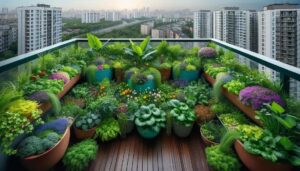Imagine stepping out onto your patio and picking fresh, juicy tomatoes right from your **container**. Growing tomatoes in a **container** on your **patio** isn’t just for those with ample backyard space; it can be a delightful reality for anyone with a **small space**. Let’s explore how easy it is to start your own mini tomato farm.
choosing the right container for patio tomato growing
Choosing the right container is critical for growing healthy tomatoes on your patio. Start by selecting a container that is deep and wide enough to support the roots. A depth of at least 12 inches is recommended. Containers made from materials like ceramic, plastic, or wood can work well, but ensure they have adequate drainage holes at the bottom to prevent waterlogging. This helps to avoid root rot, a common issue in container gardening.
Consider the Material
Plastic containers are lightweight and affordable, making them easy to move if necessary. Ceramic offers a more aesthetic appeal but can be heavy and require careful handling. Wood containers, such as whiskey barrels, add charm and are excellent at maintaining soil moisture, although they might need extra maintenance to prevent rot.
Size Matters
The container size directly influences the plant’s growth. Larger containers usually yield better results as they hold more soil and moisture, reducing the frequency of watering. A 5-gallon container is a minimum size for a single tomato plant, but larger is always better to ensure the plant’s roots have ample space to grow.
Remember, the right container choice will make maintaining your backyard fruit garden both enjoyable and rewarding. It sets the foundation for a bountiful harvest.
soil tips to boost your tomato yield
Maximizing your tomato yield begins with choosing the right soil. Tomato plants thrive in nutrient-rich soil that drains well while retaining adequate moisture. Start by using a high-quality potting mix specifically tailored for vegetables. This type of mix often contains a balanced blend of organic matter, such as peat moss and compost, which improves soil fertility and texture.
Supplements and Amendments
Incorporate supplements like organic fertilizers or bone meal into your soil to provide an additional nutrient boost. These nutrients, rich in phosphorus, help guide root development and plant health. Mixing in perlite or vermiculite can improve soil aeration, ensuring roots get enough oxygen.
Ensuring Proper pH
Tomatoes prefer slightly acidic soil with a pH around 6.0 to 6.8. Testing your soil’s pH can help you make the necessary adjustments. If the pH needs lowering, adding sulfur can help, while lime can increase it. Regular monitoring helps maintain the ideal levels for thriving plants.
Remember, good soil preparation is the foundation for a successful harvest. Give your tomatoes the best chance by understanding and optimizing your soil conditions.
watering techniques for healthy tomatoes
Proper watering is essential for growing robust tomato plants. Tomatoes need consistent moisture, but overwatering can lead to roots rotting. Begin by watering deeply and less frequently to encourage strong root development. This means allowing the top inch of soil to dry out between waterings.
Watering Tips
Morning watering is ideal, as it allows moisture to reach the roots while the sun dries the leaves, preventing fungal diseases. Use a soaker hose or a drip irrigation system to deliver water directly to the soil, minimizing splashes that can lead to disease.
Monitoring Moisture
Check the soil moisture regularly by inserting your finger about an inch into the soil. If it feels dry at this depth, it’s time to water. In hot weather, tomato plants need more water due to increased evaporation.
Adjust watering practices according to the growth stage of your plants. Seedlings require gently watering, while mature plants benefit from deeper, less frequent watering sessions to enhance fruit production.
sunlight requirements for patio tomatoes
Ensuring your patio tomatoes receive adequate sunlight is crucial for healthy growth and fruit production. Tomatoes are sun-loving plants, requiring at least six to eight hours of direct sunlight daily. Position your containers in a spot where they will receive ample morning sun, as this light is less intense and ideal for growth.
Maximizing Sun Exposure
If your patio is shaded, consider using reflective surfaces to increase light exposure. Mirrors or light-colored walls can help bounce sunlight onto your tomatoes. Alternatively, use a plant caddy to move your containers throughout the day to chase the sun.
Signs of Insufficient Sunlight
Watch for signs of too little light, such as leggy growth or reduced fruiting. If needed, supplement with grow lights to provide additional energy, especially in areas with less sunlight.
Adequate sunlight not only supports photosynthesis but also enhances fruit flavor and color. Ensuring your tomatoes soak up enough rays will lead to a bountiful and delicious harvest.
common pests and how to handle them
When growing tomatoes on your patio, be aware of common pests that can damage your plants. One frequent issue is aphids, tiny insects that suck the sap from leaves, causing them to curl and become discolored. To manage aphids, spray a mixture of water and mild dish soap on affected areas or introduce natural predators like ladybugs.
Dealing with Caterpillars
Tomato hornworms are large caterpillars that can strip foliage and fruit. Hand-picking them off plants is an effective control method. Additionally, planting basil nearby can deter these pests naturally.
Preventing Blight
Blight is a fungal disease that can devastate tomato plants. Ensure proper air circulation by spacing plants well and removing any fallen leaves. Watering at the base of the plant helps keep foliage dry, reducing the risk of blight.
Regular monitoring and early intervention are key to protecting your tomato plants from pests and diseases, ensuring a healthier harvest. Encourage beneficial insects and use barriers like row covers to protect against harmful pests.
harvesting and using your patio tomatoes
Harvesting your patio tomatoes at the right time ensures the best flavor and texture. Look for tomatoes that are fully colored and slightly firm. Gently twist them off the vine to avoid damaging the plant. Consistent harvesting encourages more fruit production and helps keep plants healthy.
Storing Fresh Tomatoes
Once harvested, store tomatoes at room temperature away from direct sunlight. Refrigeration can alter their texture and flavor, so only refrigerate overripe tomatoes. For longer storage, consider making sauces or preserving in jars.
Culinary Uses
Enjoy your tomatoes fresh in salads or sandwiches. For cooked dishes, their flavor intensifies, making them perfect for sauces and soups. Grilling whole tomatoes caramelizes their sugars, adding a smokey depth to your meals.
Using your patio tomatoes creatively integrates fresh, homegrown flavors into your cooking, making each meal special. Share with friends or incorporate into various recipes to savor the fruits of your labor all season long.
Conteúdo não disponível
FAQ – Growing Tomatoes in Containers on Your Patio
What size container is best for patio tomatoes?
A container that is at least 5 gallons in size is ideal for patio tomatoes, providing enough space for root growth.
How often should I water my container tomatoes?
Water thoroughly when the top inch of soil feels dry, typically every 1-3 days depending on the weather.
What type of soil should I use for container tomatoes?
Use a high-quality, well-draining potting mix rich in organic matter to support healthy tomato growth.
How can I improve fruit production for my tomatoes?
Ensure they get 6-8 hours of full sunlight and use tomato-specific fertilizer to promote flowering and fruiting.
What are common pests and how do I control them?
Aphids and hornworms are common; control them by hand-picking or using insecticidal soap for protection.
Can I grow tomatoes on a shaded patio?
While full sun is best, tomatoes can be grown in partial shade with careful attention to sunlight exposure and supplemental lighting.



